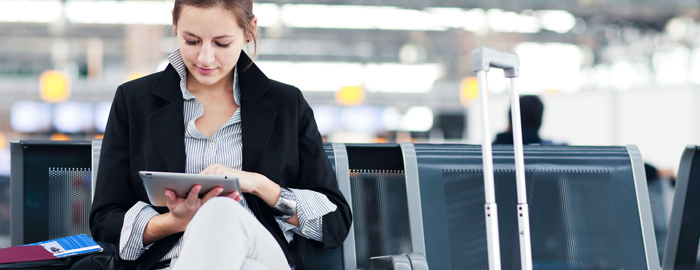Soma’s CEO believes you shouldn’t have to choose between working remotely or in an office. Why not give your staff the best of both worlds?
“Most offices are the average of what works for everyone,” says Mike Del Ponte, the founder of the water filter company Soma. “But they are perfect for no one. If you’re extremely introverted and I’m extremely extroverted, office culture creates something in the middle so neither of us is uncomfortable. But neither of us is at our optimal either.”
This dichotomy seemed too simplistic to Del Ponte, since it all depends on the type of work you are doing. There are times when teams need to be together to collaborate, but there are other times when people need to work independently, focusing deeply on a particular project. So Del Ponte came up with a hybrid approach. One week every quarter, members of the Soma team can work anywhere they choose, whether that is a coffeehouse, at a relative’s house across the country, or even at some exotic faraway destination. At Soma, they call it “Work from Anywhere Week” or WFAW. “Creativity and productivity thrive in uninterrupted time,” Del Ponte says. “And I believe both can be supercharged by inspiring environments.”
The idea for WFAW came to Del Ponte last year, when he was on a week-long vacation in Tokyo. He tried to immerse himself in the culture, getting a taste of what it was like to live like a local. When he had to stop for a moment to take an important work call or send a couple of emails, he sought out a cool cafe. It occurred to him that he could get just as much work done from a city across the world as he could in his office. And as an added benefit, he had plenty of time in the evenings to explore the city. All in all, it was a very productive week—the kind of week he wanted all his employees to experience for themselves.
He’s now made WFAW a quarterly company-wide affair. The Soma team recently had their first opportunity to take part, and Del Ponte has identified several major benefits of the new program.
Flexibility
The Soma team loved the flexibility of WFAW; it gave each person a chance to design their own unique work day. “For one of our engineers, that meant starting work early from home, taking a long lunch where he worked out, and then tackling one big project at a cafe before signing off for the day,” Del Ponte says.
Del Ponte himself decided to fly to Melbourne, Australia, for the week. His perfect day consisted of working at one cafe from early in the morning till lunch, going to another cafe to work till 3 p.m., then going kiteboarding or walking and biking through different neighborhoods, then ending the day with a nice dinner.
Inspiration
An important part of WFAW is giving employees an opportunity to find inspiration in new places. As he developed the plan for WFAW, he thought it was wise to set reasonable expectations about productivity. “I calculated that if my team members could be 80% as productive as working from the office but come back with new perspectives that would drive innovations for the company’s product, brand, or culture, it would be entirely worth it,” Del Ponte says.
In Melbourne, he visited local boutiques and was inspired by interesting new products that were doing well in the Australian market. And being in a different city means being exposed to a different culture, talking to locals, and seeing how people live their lives in different ways. By encouraging his team to be alert to these cultural nuances, his employees came back with plenty of creative new insights.
Productivity
Even though Del Ponte gave his team members the freedom to be slightly less productive than usual in terms of hitting up their to-do lists, he was surprised to find that they actually reported increases in their productivity. They found that they could create the ideal conditions to get into “the zone” by choosing the right location and time of day to do a project. Being away from the distractions of the office—the constant meetings, the ringing phones, the necessary small talk, the foosball table—can be a big advantage as well.
“When people were in new places, they were excited to go out and explore,” Del Ponte says. “They had inherent FOMO that forced them to prioritize their to-dos. The end result is that they tended to be more productive than they were in the same old desk.”
Del Ponte has learned a lot by “beta testinging” WFAW. “One mistake I made in designing the first WFAW was that I initially thought the best way to be productive was to maintain the status quo of a normal work week,” he says. “This was a mistake because WFAW is about being productive on personal projects, not real-time collaboration.”
He’s come up with a list of best practices that might help other companies who are interested in doing something similar:
Cancel All Meetings That Aren’t 100% Necessary
It’s important to realize that WFAW is about allowing employees to have large blocks of uninterrupted time to tackle things that they can’t do in the few minutes they have between meetings. He recommends canceling all standing meetings unless everyone involve agrees that a meeting is 100% necessary. And if we’re really honest, most meetings can wait a week.
Plan Your Day, And Wi-Fi, The Night Before
Del Ponte discovered early on that poor Wi-Fi can zap productivity. When traveling to a new location, he recommends looking for dependable Wi-Fi the night before, confirming the hours it is available, and always downloading email in Gmail Offline just in case things fall apart. He also recommends coming up with a list of things to work on the night before, so that you start the day focused on a series of tasks. This makes it less likely that you will be distracted by your new environment or fritter away precious time on email or Slack.
Communicate With Your Team
Since teammates will be chatting from different time zones, it is helpful to mark on the company calendar when you will be available and when you won’t. Since you won’t all be on the same nine-to-five workday, you can figure out when you should contact a teammate if you need to do so.
Set Realistic Expectations
Of course, there are some things that only work when everybody is in the same room. “If you’re developing a product and need to review prototypes, there’s no substitute for reviewing them in person,” Del Ponte says.
That said, one of the most valuable parts of WFAW is that it encourages organizations to be thoughtful and intentional about work. It forces teams to think about which meetings are essential and which can be skipped. It also forces leaders to better understand the tasks that employees are working on, giving them a chance to focus on the big projects that they need to work on independently. “It allows you to stop working on autopilot as a company,” Del Ponte says.
By Elizabeth Segran via FastCompany








